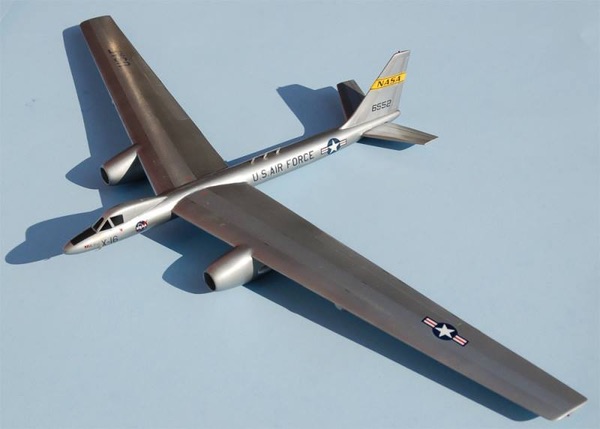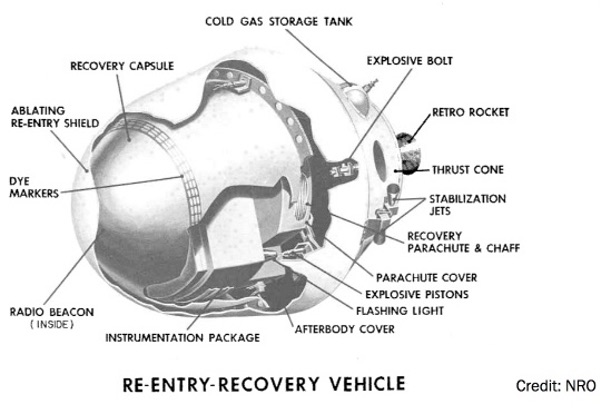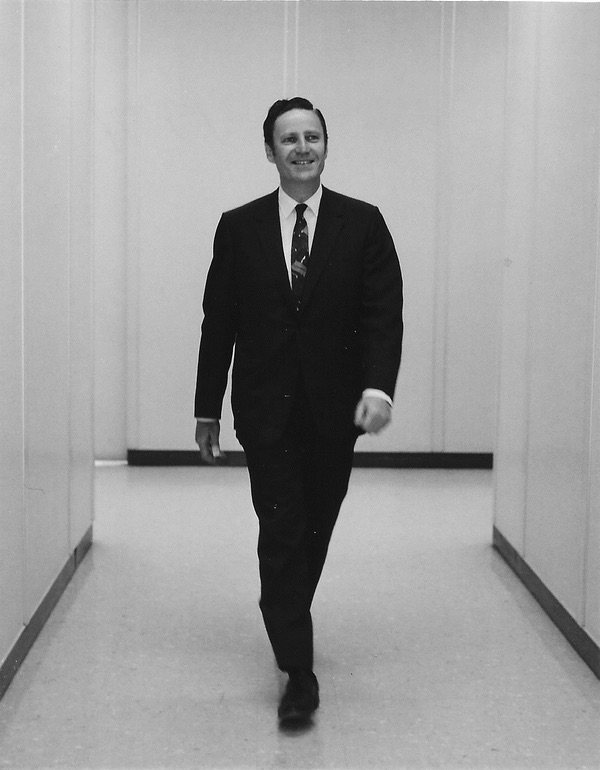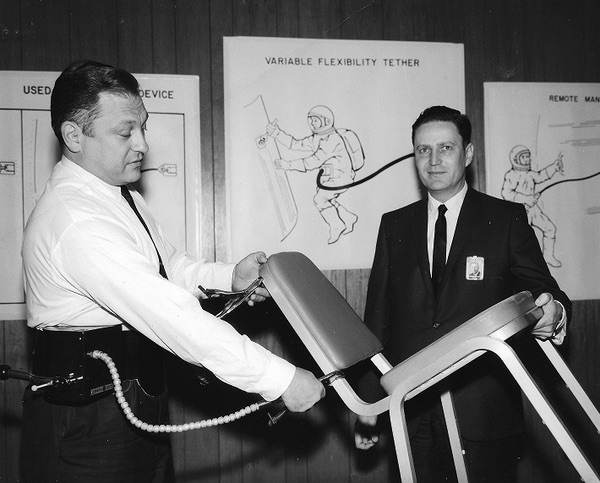Working in the shadow space programA General Electric engineer’s work on MOL and other space programsby Dwayne A. Day
|
| “The thing [the X-16] was 90% complete when the CIA one flew,” Passman said. The CIA’s plane was the now-legendary U-2 Dragon Lady. |
After a stint as a naval aviator during World War II, Passman began a career in engineering in the 1940s. “I have my masters in aerospace and in mathematics too, from the University of Michigan,” he explained in the interview. He conducted an analysis of the aerodynamics of a Convair flying car. He soon became one of the world’s first supersonic aerodynamicists when he went to work for Bell Aircraft Company in Buffalo, New York. “I reviewed much of the aerodynamics for Chuck Yeager’s X-1,” he said. Passman later became the chief aerodynamicist for the X-2.
Passman spent ten years at Bell, and by the mid-1950s he was working on their X-16 aircraft “which wasn’t really an X-plane,” he said. Instead, the X-16 was a lightweight, twin-engine, high-altitude reconnaissance aircraft for the US Air Force. Cruising way up in the thin air of the upper atmosphere, the plane would carry various cameras in its payload bays and look down on adversaries, presumably safe from interception by enemy jets.
“The thing was 90% complete when the CIA one flew,” Passman said. The CIA’s plane was the now-legendary U-2 Dragon Lady. Unlike the X-16, Lockheed’s U-2 had only a single engine and was designed with very lightweight specifications—its wing did not even have a main spar running through the fuselage.
“Because we were so close, we should have had a fly off,” with the U-2, Passman remembered. “Because I knew we had a better airplane.” But Larry Bell was in bad health, and Passman didn’t think that the people in charge at Bell were handling the company well. Once the U-2 took to the skies, the X-16 was quickly canceled. Today it is difficult to find much information about the aircraft, or photographs of the hardware that Bell was building.
The cancellation of the X-16 did not really affect him. “I left Bell when the X-2 was supposed to have its last flight and I applied to many companies,” Passman explained. “I got jobs at every one of them, but I went to GE in Philadelphia.”
 Model of the Bell X-16 high-altitude reconnaissance plane. Richard Passman was one of the chief designers of this aircraft, which was nearly complete when canceled in favor of Lockheed's U-2. (credit: Niagara Aerospace Museum) |
Reentry vehicles
Passman soon became a program manager for General Electric’s reentry vehicles, starting with ballistic missiles and later including satellites. Early reentry vehicles, until the latter 1950s, generally used the heat-sink approach, carrying a large mass of copper to absorb the heat of reentry and keep the nuclear warhead cool enough so that it could detonate over its target. But heavy reentry vehicles limited the range of the missiles. GE began developing ablative technologies, which used materials that essentially burned away as they got hotter, carrying away heat and creating a thin insulating shield between the air and the vehicle as it sped through the atmosphere. Ablative-coated reentry vehicles could be much lighter and also enter the atmosphere at higher velocities. “We increased the range and the accuracy of the missiles,” he explained. The reentry vehicles were used on the Atlas and Titan ICBMs, and Passman later started the program to make reentry vehicles for the Minuteman missile.
| “We generated our own studies so we’d have some results to show to the various agencies about it.” But Passman said it was not clear that any of the advanced human spaceflight plans were really going anywhere. “You always felt that they weren’t going to get to do this.” |
Passman also began working on reentry vehicles for satellites, particularly the CORONA reentry vehicle, which had its first flight in early 1959. The CORONA stored exposed film inside its reentry vehicle and the film had to be kept cooler than a nuclear warhead. The CORONA satellite recovery vehicle, or SRV, was blunter than the missile reentry vehicles that GE was then producing, enabling it to maintain the lower internal temperatures required to keep the film safe until it could be recovered and transported to a development facility.
By the late 1950s, GE was working on human spaceflight studies, mostly funded with company money. “I had a group under me, a manned [spaceflight] group, and we worked very closely with both NASA and the Air Force,” he remembered. “We generated our own studies so we’d have some results to show to the various agencies about it.” But Passman said it was not clear that any of the advanced human spaceflight plans were really going anywhere. “You always felt that they weren’t going to get to do this.” He said that to some extent the company’s human spaceflight proposals got bounced back and forth between NASA and the Air Force, because it was not clear which government organization was going to be responsible for human spaceflight in the future.
 Satellite recovery vehicle developed by General Electric for the CORONA reconnaissance satellite. GE manufactured hundreds of these starting in the late 1950s and variants were also used on the ARGON, LANYARD, GAMBIT, and HEXAGON programs as well as NASA’s Biosatellite. (credit: NRO) |
Winning the contracts
By the early 1960s, Passman became responsible for bidding on new contracts for General Electric. He worked on the SNAP-27 radioisotope thermoelectric generator proposal which the company won and later produced to power science experiments on the Moon.
Passman also led the company’s bid on the KH-7, GAMBIT-1 reconnaissance satellite. GAMBIT-1 was a satellite that produced higher-resolution photos of equipment on the ground good enough to determine their technical characteristics, like the difference between two fighter jets. GE built the spacecraft and the software that controlled it, as well as the reentry vehicle for returning the film. The reentry vehicle was derived from the one used on CORONA.
Hill Page was a key person at GE and Passman reported to him. “He gave me all the support I needed” to win contracts, Passman said. “He said to me, don’t you ever tell me that you didn’t win those because there wasn’t enough money, I didn’t give you enough money,” Passman remembered. “I didn’t have as much money as some of our competitors. But that was never a reason” they did not win. “I thought he was a very great person,” he said of Page.
Passman said that there was one project that GE lost out on that he wishes they had won, the Command and Service Module contract for Apollo. That contract went to North American, even though the company had not scored high on its contract evaluation. “I think NASA decided they wanted them to do it because they did such a good job with the boosters and the staging with the rockets,” Passman speculated. “I knew those people too. They excelled in what they did.” It was the one big contract that got away. “I think that was the engineering job of the century.”
GE and the Manned Orbiting Laboratory
By funding the internal studies on human spaceflight, GE had built up a knowledge base. When the Air Force put out the contract for the Manned Orbiting Laboratory in 1964, Passman led GE’s contract proposal. “We won it competitively,” he said. GE was then in charge of most of the systems on the MOL. That didn’t mean that they built everything. “We didn’t make the life support system,” he offered as an example, “but we were in charge of it.”
| Several of the MOL astronauts were sent to Philadelphia to work with GE’s engineers. “There were about four of them who came down and lived with us for several months and we went over the overall program and what we wanted and what they needed. A pretty wild bunch, but they were good people.” |
“MOL was a big job, but we had already figured out how we were going to do it” while preparing the contract proposal. “We had to hire people with the understanding of the various parts.” He eventually became deputy director for all technology of the Manned Orbiting Laboratory.
“Douglas had the overall integration job, but they really didn’t have a lot of knowledge about it. We did all the software on the unmanned one [GAMBIT] as well. We had been working with the Air Force on that for many years. So, we had lots of knowledge into the overall program.” That also gave them a leg up when working on MOL, which was a much more complex system. “It was both analog and digital computers that we used in order to affect the devices.”
GE had to hire a lot of people to work on MOL at the same time that the Apollo program was in full swing and occupying numerous aerospace companies across the United States. “I don’t think we had any difficulty getting people,” Passman said.
Because MOL was a manned spacecraft, it was important to understand what the astronauts needed to do and how they would operate in space. Several of the MOL astronauts were sent to Philadelphia to work with GE’s engineers. “There were about four of them who came down and lived with us for several months and we went over the overall program and what we wanted and what they needed. A pretty wild bunch, but they were good people.” He remembered that Bob Crippen and Richard Truly were two of the MOL astronauts that worked closely with GE’s engineers. “I don’t know if they’d remember me, but I did spend a lot of time with them.”
Sometime, probably in 1966, Passman got called to a high-level meeting to brief the Secretary of Defense, Robert McNamara. According to Passman, somebody from Douglas was supposed to brief McNamara, but they did not have a good understanding of how the whole MOL system operated, so the briefing really fell to him. “We had a big secret meeting with McNamara at about the one-year mark. I gave the technical briefing. He had some good questions, by the way, and he decided not to cancel it.”
According to Passman, McNamara said that he had called the meeting because “he was getting all the information he needed from the unmanned one [GAMBIT], which I found surprising. But obviously, I couldn’t dispute it.” McNamara wanted to understand why they were funding MOL as well as GAMBIT. “The difference in resolution between the two was an order of magnitude. But he was privy to what he wanted, and I was not.”
“On most programs, you know, we’re super-secret,” he added. “When we talked with McNamara, we flew into one city and rode in the car and drove to another city, and he had to do the same thing.” Although MOL’s existence was publicly acknowledged, its actual mission was highly classified.
“We were warned that he was considering canceling the program,” Passman remembered of that meeting with McNamara. But at that point, Passman was not trying to win a contract, but to serve the customer. “Of course, when you’re reviewing at those levels, you’re not really selling yourself. You’re not deluding the guy who is asking you the questions, because these issues are of national importance.”
Passman felt that he had to be totally honest in that situation. “I remember telling him that he wasn’t going to see a lot of data,” in terms of square kilometers of ground photographed from the MOL missions. For a reconnaissance satellite, it was important to photograph as much territory as possible on each mission. “A lot of it was like: as far as we could see—the last bit to the right… not directly underneath you.” But because MOL’s camera system was so powerful, it only photographed small areas of ground at a time. McNamara needed to know the full capabilities, and limitations, of MOL’s powerful reconnaissance system. “So he would know what he was looking at” and how it compared to other existing and planned reconnaissance systems. Passman understood that national security depended on these systems. “So, there’s a responsibility to be a good citizen as well as a proponent for your program,” he said. “When McNamara said he got all he wanted from the unmanned one, we couldn’t really complain” that he was wrong.
| “But I wasn’t surprised because we were told a year earlier” that McNamara had been having doubts about MOL. “And so I wasn’t, I wasn’t really surprised that happened.” |
Within only a few years of program start, MOL was over-budget and behind schedule. Passman said that the contractor got all the money they were promised. “I think it was fully funded,” he said. But he said that MOL exhibited a problem that he had seen with previous Air Force projects, which did not budget for all the money that they knew they needed when they started. “Generally, the Air Force projects always overran” their budgets, Passman said. “For a good reason.” When the Air Force program officers wrote up their initial budgets, there were things they didn’t know and had to guess at, and they often eliminated things that were important but did not seem important. Once the work started, it would become apparent that the system was being designed to the wrong assumptions. “So, it had to be redesigned,” he said. “You couldn’t negotiate the [contract] win to include reasonable things to be done. They were under pressure to reduce the money that they asked for.” He assumed that MOL was following the pattern he had seen before. “So that there’s no surprises this overran.”
MOL was canceled in summer of 1969. When asked if he was surprised about the cancellation, Passman answered both yes and no. “Everything was going well and it wasn’t canceled because of any deficiency, either our work or Douglas.” It wasn’t canceled because of obvious technical or schedule problems. “But I wasn’t surprised because we were told a year earlier” that McNamara had been having doubts about MOL. “And so I wasn’t, I wasn’t really surprised that happened.”
Passman said that about 8,000 people at General Electric were working on space and missile projects, and about a third of them were on MOL. “It wasn’t the first time a big program got canceled and people had to be laid off.” It was rather common in the aerospace industry. He did not expect MOL to come back either. “It was canceled and was gone,” he added.
When asked if he ever missed doing supersonic aerodynamics, he said “No, I guess I didn’t miss it, but I always enjoyed it. I really loved doing that.”
Richard’s son, Bill, wrote in an email about his father that he was always interested in supersonic flight and space stations and co-authored a book about the X-15. “I know that his work on MOL, which was a downward looking camera, mirrored his work at GE on civilian projects like NIMBUS, weather satellites looking down and helping predict weather, and ERTS/LANDSAT-1, looking down and performing multispectral imaging for crop planning and management on Earth.” Bill Passman added that he believed his father’s work on MOL was instrumental to him later getting a job at Grumman to work on NASA’s space station program in the 1990s. “I remember him talking to me one time that at a meeting he was able to provide key suggestions on vehicle thermal management that was based on his prior knowledge of how things were done for MOL,” Bill Passman wrote.
Bill Passman also added that his father was recognized within GE as an excellent manager, and was selected to take many courses at the GE training campus in Crotonville, New York, where he received the equivalent of an MBA. It gave him the skills to manage the myriad space projects he won for the company.
 Richard Passman in 1971, when he as a senior manager on General Electric's space programs. (credit: Bill Passman) |
Note: we are temporarily moderating all comments submitted to deal with a surge in spam.
